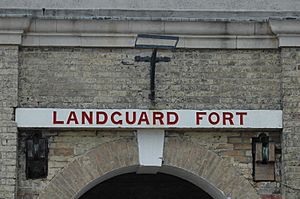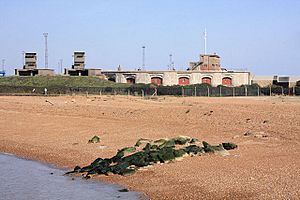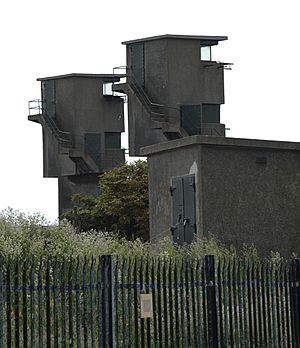Landguard Fort facts for kids
Landguard Fort is a historic fort located at the entrance of the River Orwell. It sits near Felixstowe, in Suffolk, England. Its main job was to protect the river mouth from invaders. Today, a charity called English Heritage looks after the fort, and you can visit it to explore its past.
Contents
The Fort's Early Days and Design
Landguard Fort was first known as Langer Fort. The very first defenses were built around 1540. These were simple earth mounds and a small strong building called a blockhouse. Later, in 1621, King James I ordered a bigger fort to be built. This new fort was square-shaped with strong corners called bulwarks to help defend it.
A Famous Battle at Landguard Fort
In 1667, a big event happened at Landguard Fort. About 2,000 Dutch soldiers, led by Michiel de Ruyter, landed on Felixstowe beach. They marched towards the fort, planning to capture it. However, the fort's defenders, led by Nathaniel Darrel, fought back bravely. There were 400 musketeers (soldiers with muskets) from the Duke of York & Albany's Maritime Regiment, who were the first Royal Marines, and 100 artillerymen with 54 cannons. They successfully pushed back the Dutch attack. This event is known as the Battle of Landguard Fort.
Changes and Upgrades Over Time
Over the years, Landguard Fort was updated many times to keep it strong.
- In 1717, a new gun battery was added.
- A completely new fort was started in 1745 on a nearby spot. It had a five-sided shape with strong bastions (parts of the fort that stick out).
- More batteries were built in the 1750s and 1780s.
- The biggest changes happened in the 1870s. The living quarters inside were rebuilt to look like a castle keep. The side facing the river was also rebuilt with new gun positions.
Landguard Fort During World War II
During the Second World War, Landguard Fort played an important role.
- It was a main base for the big guns that protected Harwich Harbour. By 1941, there were several powerful guns ready for action.
- It also served as a control center for anti-aircraft guns in the area.
- The fort had a Naval Port War Signal Station. This station controlled all the ship movements in and out of Harwich Harbour.
- It was a remote control station for defensive minefields placed in the harbor entrance.
Observers at the fort watched for enemy planes and ships. They recorded many air raids and shipwrecks. In 1944, the fort's guns fired at what they thought were German mini-submarines in the harbor. Later that year, Allied landing ships used nearby piers to load up.
One interesting project launched from Landguard Fort during the war was called Operation Outward. This project involved sending thousands of free-flying hydrogen balloons towards Germany. These balloons carried either fire-starting devices or long steel wires designed to damage power lines. This operation took place between 1942 and 1944.
The Army finally left Landguard Fort in 1957.
Visiting Landguard Fort Today
Today, Landguard Fort is a well-preserved historical site. It is looked after by English Heritage and is open for visitors. You can explore the fort's different areas and imagine what life was like for the soldiers who defended it throughout history.
See also
- Governor of Landguard Fort
- Walton Castle, Suffolk




